#seed saving
Explore tagged Tumblr posts
Text
Dandelion News - January 1-7
Like these weekly compilations? Tip me at $kaybarr1735 or check out my Dandelion Doodles!
1. Homes built with clay, grass, plastic and glass: How a Caribbean island is shying away from concrete
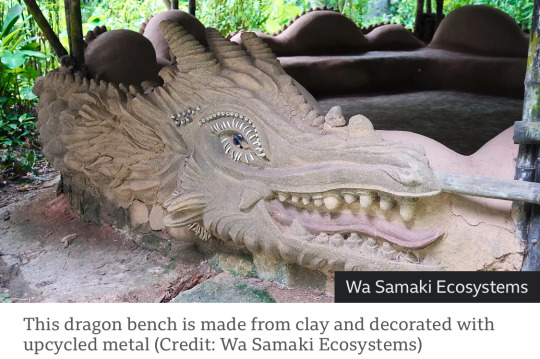
“[… Clay] traps moisture which then evaporates and pulls heat from the surface as it goes. […] The roof is covered in old recycled advertising banners and piece of a water tank, the other half of which is used to house some of Rahaman-Noronha's fish [… and] multi-coloured glass bottles inset into walls provide an avenue for streams of light and colour.”
2. To Combat Phoenix’s Extreme Heat, a New Program Provides Sustainable Shade
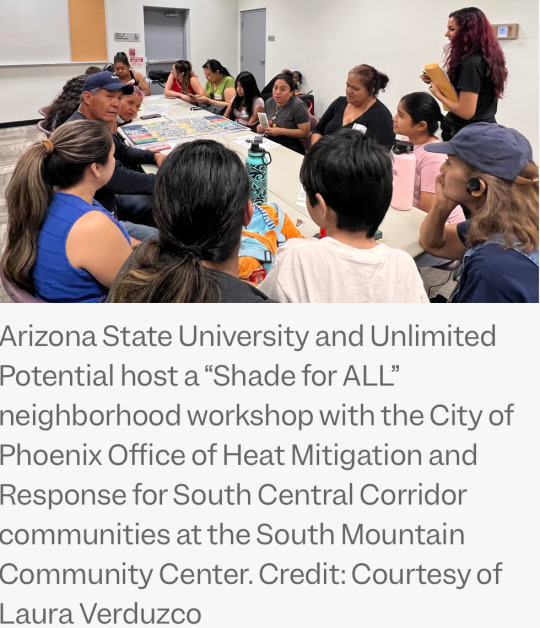
“The neighborhood workshops allow residents to get a shade plan tailored to their community’s needs and identify the locations where officials can plant trees. Meanwhile, the workforce-development side of the program creates the jobs needed to keep the trees alive for generations[….]”
3. Conservation corridors provide hope for Latin America’s felines
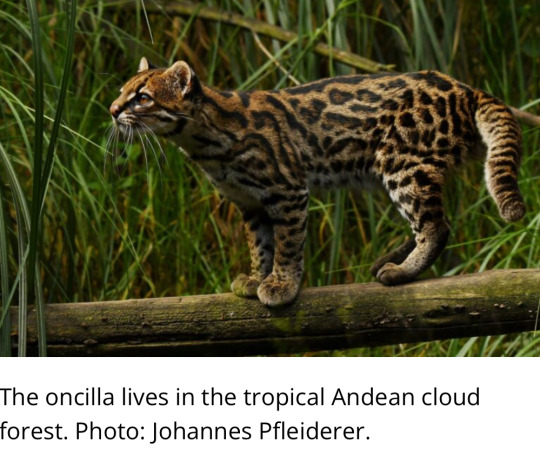
“[… S]cience has shown that to maintain healthy populations there needs to be connection between individuals. [… A] protected area that is close to another has more species and more potential for their survival.”
4. Social program cuts tuberculosis cases among Brazil's poorest by more than half

“The decrease [“in TB cases and deaths”] was over 50% in extremely poor people and more than 60% among the Indigenous populations. […] "We know that the program improves access to food [… and healthcare…] and strengthens people's immune defenses as a result.””
5. Geothermal has vast potential to meet the world’s power needs
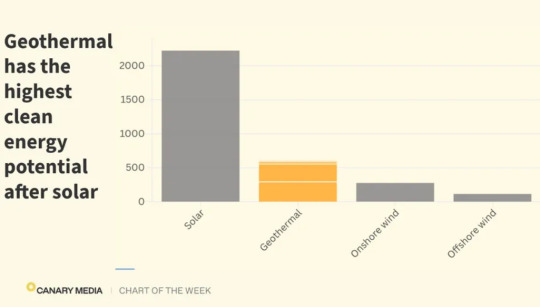
“New geothermal systems could technically provide as much as 600 terawatts of carbon-free power capacity by 2050[…. C]ountries could cost-effectively deploy over 800 GW of geothermal power capacity using technology that’s in development today[….]”
6. New D.C. Catholic archbishop is pro-LGBTQ+ and anti-Trump

“In 2018, he objected to the blaming of gay priests for the clergy sexual abuse crisis, “saying that such abuse was a matter of power, not sexual orientation[….]” “We must disrupt those who portray refugees as enemies [… and] seek to rob our medical care, especially from the poor.””
7. Chesapeake Bay Will Gain New Wildlife Refuge
“The Chesapeake Bay area will have a new wildlife refuge for the first time in a quarter century. […] “This new refuge offers an opportunity to halt and even reverse biodiversity loss in this important place, and in a way that fully integrates and respects the leadership and rights of Indigenous peoples and local communities.””
8. Inside Svalbard seed vault’s critical mission to stop our favourite fruit and veg from going extinct
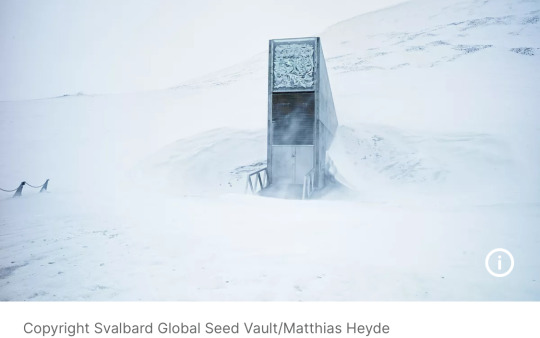
“[… T]he world’s largest secure seed storage […] sits proudly in a massive former coal mine[….] Right now, there are over 1,331,458 samples of 6,297 crop species. […] “During 2024, 61 seed genebanks deposited 64,331 seed samples, including 21 from institutes that deposited seeds for the first time this year[….]””
9. Medical debt will be erased from credit reports for all Americans under new federal rule

“The rule will affect more than 15 million Americans, raising their credit scores by an estimated average of 20 points. [… S]tates and localities have already utilized American Rescue Plan (ARP) funds to support the elimination of over $1 billion in medical debt for more than 700,000 Americans[….]”
10. 'Forgotten' water harvesting system transforms 'barren wasteland' into thriving farmland
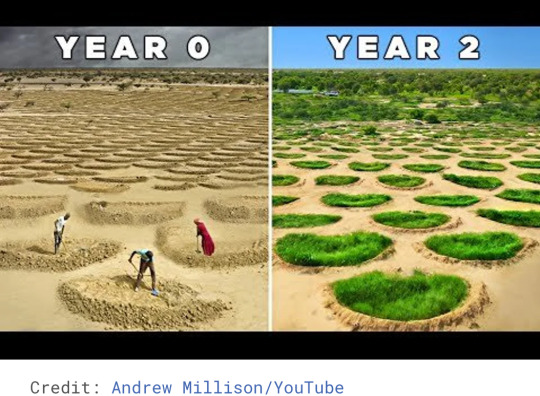
“"The process started with the community-based participatory planning[….]” 10% to 15% of the water will actually soak into the ground to replenish the water table, creating a more sustainable agricultural process.”
December 22-28 news here | (all credit for images and written material can be found at the source linked; I don’t claim credit for anything but curating.)
#hopepunk#good news#recycling#upcycling#climate change#climate action#trees#habitat restoration#habitat#big cats#cats#latin america#brazil#tuberculosis#poverty#geothermal#clean energy#renewableenergy#catholic#lgbt+#lgbt#lgbtq#religion#christianity#wildlife refuge#wildlife#seed saving#seed bank#medical debt#anti capitalism
308 notes
·
View notes
Text
Preliminary planning started back in 2011, and in 2020, the reservoir action management plan, a detailed 260-page document��was published by the Klamath River Renewal Corporation – the non-profit entity formed to manage the entire dam removal project. ''The document gave us our targets, and has kept us on track," says Joshua Chenoweth, senior ripariani ecologist for the tribe who was hired to manage the revegetation project. Between 2018 and 2021 seed collection crews – many of whom are tribal elders – were hired to harvest native seeds, by hand, in preparation for the dam removal. They collected 98 species and around 2,000lbs (900kg) of seeds. The seeds were then dispatched to specialised nurseries, which propagated them en masse, and sent the seedlings to storage facilities where they were kept until the time came for them to be planted.

When it came to planting the seeds, Chenoweth has used a variety of methods, including seeding by helicopter alongside the old-fashioned way, by hand. Beginning straight after the first draining in late 2023, the team hand-sowed 500 acres of land, including 25,000 acorns. "It really is the most effective restoration tool. And the only reason we used a helicopter was when muddy conditions made it too dangerous for us to walk on the land." The results were "excellent", Chenoweth says. "Despite a hot and dry summer, where we've seeded is green, we're seeing flowering plants teeming with life. I counted eight different butterflies in the areas we hand-seeded. There's moths, hoverflies, bees, birds. It's been a really exciting first year." The team will continue to seed and plant the area for another two years, prioritising the tributaries important for salmon habitat. "The first year has definitely given me a lot of hope," Chenoweth, "but it'll probably get more challenging from here. Now we're completely at the mercy of Mother Nature."
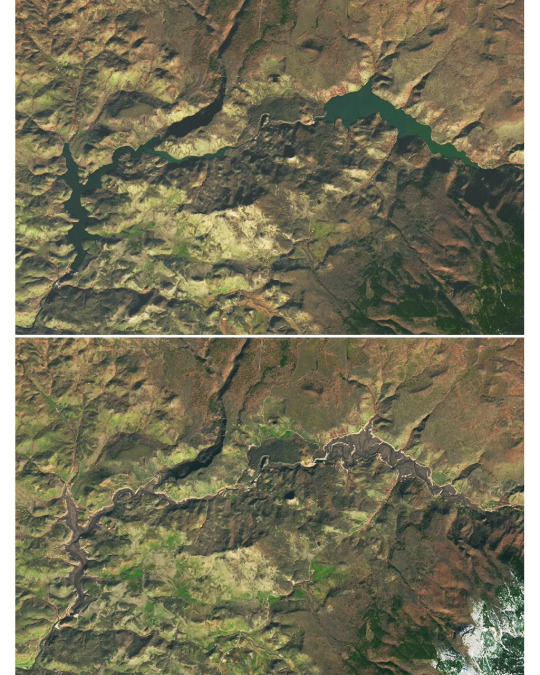
176 notes
·
View notes
Text
For Christmas I got most of my family members a pack of heirloom seeds picked out just for them. They’re the classic kind of gardeners — they grow their peas, zucchini, tomatoes, etc. pretty much the same way as my great-great-grandparents did, with seeds bought from the same store. I’ve always been the one to branch out, and it was a lot of fun picking out seeds that would be fun for them without freaking them out too much. So I got things like Holstein cowpeas for my brother who works in dairy farming, turkey craw beans for my brother who’s a hunting enthusiast working on his turkey super slam, and giant rattle poppies for my sister-in-law who enjoys baking and flower arranging. For my niblings I got fun variations on things they already grew, like dragon tongue beans and pineapple squash.
I also gave out seeds I saved from my garden, and I’m proud of how the seed packets I made turned out!

The okra and rats tail radishes are new to them, but I think they can handle it. And I think I’ve convinced some of my family to try the love of my life next year, Swiss chard
To top it all off, all of the seed packets were “wrapped” by putting them in the envelopes from our leftover wedding invitations (from years and years ago, and printed with an old address so they’d be a pain to use for anything else)
#I’m definitely doing it again next year#upcycling???#seed saving#gardening#the habitat ring#solarpunk
59 notes
·
View notes
Text

102 notes
·
View notes
Text
saving seeds does NOT save you money but rather allows you to use the same allowance to try new seeds.
#oh no i bought more seeds nobody can stop me#gardening#home garden#food not lawns#homestead#homesteading#nature#homegrown#grow food#gardenblr#food#garden blog#seed saving
133 notes
·
View notes
Text
We have had 3 hard frosts and the veggies still pull through. It pays to save your seeds as seeds have a memory.
Booking tours now through mid April 2025.

#visionarygrowingsolutions#compost#atlanta urban ag#simplefoodsmallfarmz#winter growing#atlanta airbnd experience#air bnb experience atlanta#biodynamic#soil#biodiversity#permaculture#urban ag#food systems#soil health#simple food small farmz air bnb agriculture experience#atlanta air bnb urban agriculture experence#airbnb experience#seed saving#winter crops#swiss chard#maurice small
47 notes
·
View notes
Text
I really thought that i couldn't participate inthis solstice Solarpunk Aesthetic Week but surprise!!! A friend decided to give their father some local seeds as Christmas gift. The contacts flew and suddenly I'm in the middle of a seed swap!

Giving seeds of black popcorn, a variety of beans, red okra and Pau-Brasil.
I might receive a slice of pie, and seeds of a type of cucumber, shiso and a different type of bean.
#seed saving#seed sharing#solarpunk#solarpunk aesthetic week#summer planting#summer solstice#Tinta speaks
33 notes
·
View notes
Text


2025 Garden line up 👨🌾
What are y'all growing this year?
I also impulse bought a ton of flax seed a while back with the plan of growing flax to spin but I dont think ill have the room for that this year...
#gardening#seeds#garden#gardencore#vegetables#veg#vegetable garden#vegetable gardening#organic gardening#permaculture#growing food#growing#seed saving#heritage#food#food forest#cottage core#community aid#community action#food preservation#organic garden#gardenblr#organic#organic vegetables#farming#garden plot#allotment
24 notes
·
View notes
Note
Saw ur post on insta about milkweed. Are you telling me that I’ve been manually separating my seeds from the fluff for years and am only just now learning this trick?!?!!!!???
Mind = blown, thank you so much for sharing
Happy to assist.
For those who haven't seen it:
235 notes
·
View notes
Text

It's easy to see why I chose these pods to mature, dry and save seed from.
They are all long, well filled out with multiple seeds and all come from the same plant. The plant itself was vigorous and prolific. These are the traits I want to keep and develop for the future.
Purple King climbing beans are one of my favourites.
#beans#garden#gardeners on tumblr#vegetables#gardening#self sufficiency#home grown#plants#organic food#climbing beans#seeds#seed saving#purple king climbing beans
16 notes
·
View notes
Text
Collecting Milkweed Seeds - All Facts, All Seeds, No Fluff
(OK but please also consider I'm not an ~expert~ I'm not a ~scholar~ I'm just a nerd on Tumblr who really likes milkweed and wanted to make a fun lil post about it)
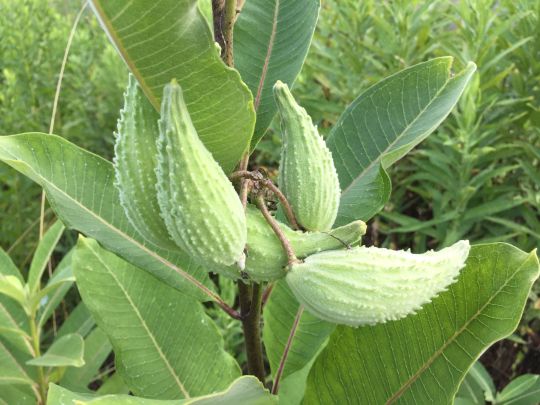
[Image ID: a green, leafy common milkweed plant (Asclepias syriaca) with five large, ovalish and bumpy green seed pods. The seed pods are currently unopened.]
It’s fall, which means if you haven’t seen them already, now’s the time that milkweed plants will start producing seed pods! (Well, technically, they’re called follicles, but fuck it they’re seed pods). Each pod has dozens of seeds inside, some species can even have up to 200 seeds, so even collecting just a few can be a good way to boost your pollinator gardening efforts big time! What you do with them then is up to you--adding life to your backyard garden, sharing with friends, making seed bombs--but first you’ve gotta collect them.
The first thing you want to do is identify your milkweed plants--in an ideal world, you’d be able to tell precisely what kind of milkweed you’re collecting from (so you can know precisely what growing conditions that species prefers.) But when they’re dying back, forming pods, and releasing their seeds, it can be hard to tell. It helps to visit sites early, to know what milkweeds are there, and while you’re there you might even find some forming pods.
It can be helpful to band off the pods early! This will keep the seeds from escaping, so you can come back later and collect them! I would only do this for a couple of pods--each pod has a lot of seed in it, so only taking one or two from each plant should still net you plenty of rewards! When I’m doing this in my backyard, I tend to use rubber bands--the size of rubber band you’ll need varies depending on the species. I’ve also seen people use the lacy-looking jewelry bags to a similar effect--if the pod splits open, all the seeds get trapped in the bag!

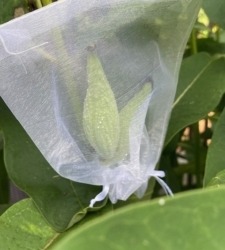
[Image ID: the first image is of appears to be swamp milkweed (Asclepias incarnata) with about fifteen long, green, smooth and pointed seed pods. Most of the pods have small black rubber bands wrapped around the midsections. The second image is of what appears to be common milkweed (Asclepias syriaca) with two large, ovalish and bumpy green seed pods. A white fine mesh bag has been tied over the pods.]
For people who want to get seeds from unopened pods, you have to be very careful not to force open a pod that isn’t ready--otherwise, the seeds inside won’t fully develop. How do you tell if a pod is ripe? There’s a seam in each pod, and it should open fairly easily with minimal pressure if it’s basically ready. If you’re basically prying it open, you’re too early. The seeds inside should be a nice dark color, and be plump in the middle--if they’re creamy colored or light orange, you’re too early. There may be some undeveloped seeds in each pod (I am talking maybe 1 to 3 here), but if the majority of them are ready, you’re good to go!

[Image ID: a tropical milkweed (Asclepias curassavica) seed pod that has been opened at the seam, revealing dark brown seeds and lots of creamy white floss. Four seeds are floating away from the pod on fluffy white comas. The pod is being held between a white person's fingers.]
I’ve also seen people who go late late late into the season, after most of the pods have already fully split off and released their seeds. Some of the seeds occasionally stay in the pod, so they’ll take the leftovers that didn’t get scattered after winter passes. That’s a fair strategy! I prefer to get mine way early on, so I can get a clear ID of what kind of milkweed it is (some will flower and produce pods at the same time), but if you already got an ID early in the season and then come back later this can also work! But…

[Image ID: several dried brown seed pods have opened fully, releasing a cloud of milkweed floss with seeds attached. Some seeds are still in the pods, but many are primed to float away.]
There is, however, one thing that tends to be a bit annoying about collecting milkweed seeds--and that’s the fluff. These fluffy white bits attached to the seed--called comas--function similarly to the iconic fluffy dandelion seed. A milkweed seed’s coma allows it to float through the air and on the water until it (hypothetically) reaches bare soil or an otherwise suitable start to settle down and germinate. If you’re collecting the seeds for later use, though, that same coma can mean your milkweed seeds are traveling through the air and away from where you’re collecting them, or all over your apartment once you get them home. Removing the comas by hand is an option, but tedious, and still leads to a nice pile of fluffy that will get airborne at the first gust of wind. At the end of the day, for many people trying to collect milkweed seeds, the coma is just an annoying part they dread.
Fortunately, there are plenty of ways to collect milkweed seeds without having to deal with the comas long-term!
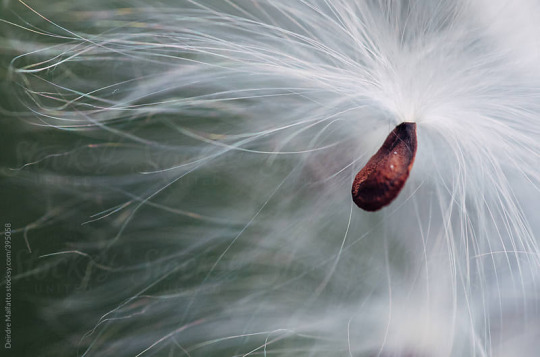
[Image ID: A single brown milkweed seed floating on a comparatively huge mess of white fibers.]
Method 1
So this is my favorite method because it's honestly one of the simplest and easiest once you get used to it. You open the pod, grip the top part of the middle ‘pith’ section tight, and gently scrape off the seeds into a bowl or bag. This leaves you with almost no fluff in your collection bin, and you can then toss the middle fluffy part--or I’ve heard of people collecting milkweed fluff for spinning! Most of the videos I’ve seen on it use common milkweed or other large milkweed pods as an example--however, I’ve successfully done this with smaller milkweed pods like A. curassavica as well.
youtube
Method 2
This method is one I’ve used in the past. Take the seeds and fluff and put them into a bag (paper or plastic) and add a coin or two. Shake the bag around--a lot. The coin will dislodge the comas from the seeds. The seeds will then drop to the bottom of the container, and the fluff will float around on the top. I’ve also seen this with buckets and blocks, like in the video below!
Method 3
I’ve seen a handful of people discuss burning the floss of the seeds! Apparently the seeds themselves aren’t damaged badly by the fire, though honestly this is a method that I am simply too anxious to try myself.
youtube
Method 4
This was a method I found while I was looking for other methods people have done. Apparently, you can just roll the pod between your hands and it’ll work to dislodge the seeds? I may have to try it next time!
youtube
Hopefully this advice is helpful for you all! I know collecting seeds was a hassle for me before I learned my favorite method. If I had a nickel for every time I got yelled at for releasing milkweed fluff into the house...
If you've got a method that I haven't heard about yet, let me know!! I'm always down to learn more about milkweed, and it can also help someone else down the line!
#milkweed#asclepias#seed saving#seed collecting#pollinator garden#outdoor gardening#gardening#flowers#ani rambles#out of queue#i think this was my first time doing image descriptions??? if they suck ass let me know and I'll Make Adjustments As Recommended#i've seen people talk about spinning the milkweed floss??? but I saw online that it was too brittle to be spun????#but either way if you wanna save the floss and do Stuff with it go for it#did you know. or actually this is me functioning from memory.#but if I recall correctly I believe in either the WWI era or the WWII era#people would pay kids to go around fields collecting milkweed seed pods and pay them by the pound#and then they'd take the floss and use it to fill life jackets for soldiers?#i think this was less of a 'extorted child labor sweat shop' deal and more of a like#'hey kids wanna earn some cash and also be a Patriotic Citizen? go find some seed pods and we'll give you money'#which i guess many people WOULD consider an Extorted Child Labor kinda deal but like#idk seems like a chill deal to me#anyways hope you guys like this post#Youtube
217 notes
·
View notes
Text
gardening update || 12/01/24 🏡🌱🌼
was out in the garden today to water a bit and we've got good news and bad news...
bad news is one of my 3 veggie/crop raised beds is just absolutely wilting... i have no idea why bc it wasn't like this the last time i checked two days ago, but now everything looks so sad and miserable



i am very confused as to why... am i over watering?? was it too cold??? do they not have enough mulch??? should i buy more straw to mulch them more???? aaaaaaa i have no idea please help 😭😭
onto the good news...



i harvested a ton of different flower seeds in the garden! we have violas, coneflower, zinnia, and my pink cosmos! i definitely still have more to learn about seed collecting and seed saving, but i'm still just beginning and i have time to learn & hone the skill!
the viola seeds are really interesting, they remind me of one of the monster things from stranger things lol. i only caught glimpses of the show when my dad was watching it, but they remind me of these guys:
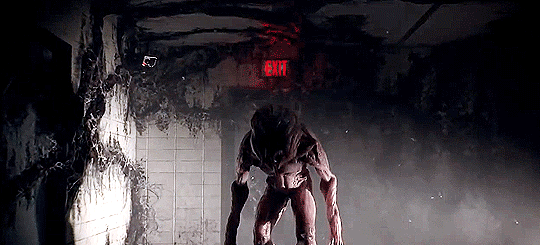
#hobby: gardening#gardening#gardenblr#garden blog#garden#raised garden beds#garden bed#seed saving#seed collecting#seeds#seed#viola#violas#coneflower#pink cosmos#cosmos#zinnia
18 notes
·
View notes
Text
3 19 2025
Hello everyone here's the update for now :)
The littlest peeps update

These ones will be moving to the 2+ month old grow space soon and I'll be putting together a 3rd grow out space before integrating the newbies.
In addition come the 23rd-27th, we've a potential for 6 more chicks (though we don't expect all 6 to hatch). These hatches will most likely be sold to pay for feed (our ultimate goal is to have them paying for themselves as much a spossible).

One of our "free seed" areas, this was jsut left to go wild with weed seeds and added seeds. I find it particulalry funny they had such a divide 😂 between the sunflowers and the mallow-weed. Among them looks as if theres some tomatoes and squash or watermelon along the back, though I'm keeping a close eye on both to be sure.

The adults were given all the stuff I pulled from this zone.

Stinkweed seems to be pretty spread this year :( it's invasive/considered a noxious weed . I pull it with extreme prejudice as I spot it and feed it to the hens. They slurp it up like spaghetti.

The carrots are going to flower 🤩 i am so excited for the butterflies, moths and even some of the pretty beetles and flies. I hope to catch some stunners to share!
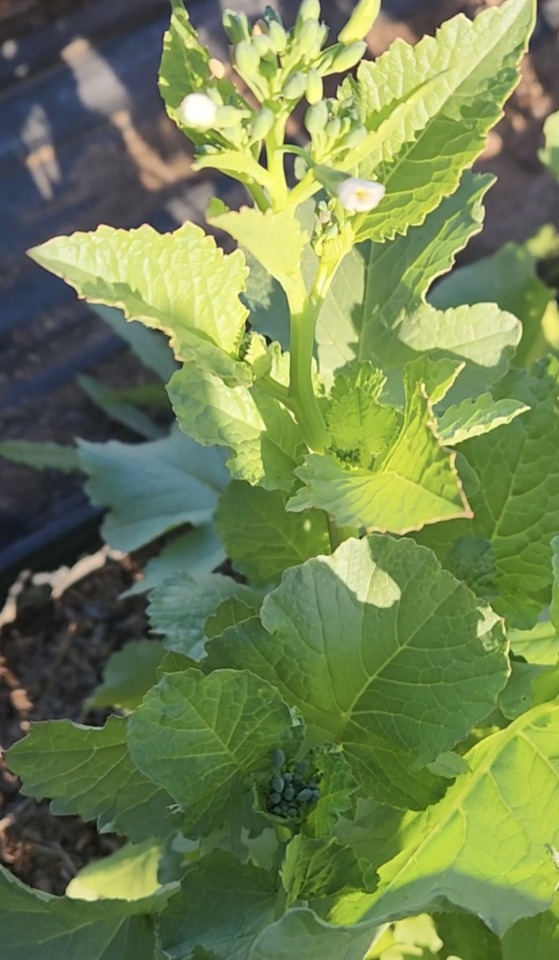
Radish flowers (breakfast radish is the variety)

The green onions from the store bought snips, their finally poking out :D
Past that, there has been lots of rain, not sure if it's potentially early monsoon or just weather skewing but it rained pretty good the last two weeks.
So I've been cooking a bit this week and quilting.
I got some mending projects finished and dyed some clothes to "renew" them.
My apologies for the short post today, but I wanted to be sure to post something as it's been a bit again. Mostly due to weather and just waiting for sprouting actions to begin.
🌱🐝Happy urban and suburban Homesteading 🐝🌱
#homesteading#thestudentfarmer#self sufficient living#studentfarmer#self sufficiency#food#garden#gardening#low waste#chickens#right to grow food#chicken salad#seed saving
15 notes
·
View notes
Text
Saving Seeds

Happy New Year! Today I'd like to talk about seed saving. Since annual crops die at the end of their season, it's important to save their seeds so that you can replant them the following year. This is a great way to practice sustainable gardening, allowing you to get the most out of your yearly harvest and spend less money on seeds.
In the photo shown above, I have seeds from six different plants: pea, sunflower, kale, habenero, cayenne, and jalapeño. We're going to go over how to collect, dry, and store each type of seed.
When saving vegetable seeds, remember to choose open-pollinated varieties instead of hybrid varieties. Open-pollinated plants will produce seeds most similar to the parent plant. You also want to choose seeds from your healthiest plant in order to produce the best possible genetics.
Peas
Peas are ready for harvest when the pods have dried out and turned a pale yellowish brown. The pod should feel dry to the touch and the peas inside will be hard. You will need to leave a few pods on the vine so that they can mature.
Once they're ready, harvest your pea pods and and break open the shells. The color of the peas will range from green, yellow, and light brown. Remove the seeds from shell and place them on a plate or saucer for drying. They should be left alone to dry for about a week.
For storage, place the seeds in a glass jar, a plastic bag, or an envelope. Store in a cool, dry place. I keep mine in the fridge.
Unfortunately I didn't get to save too many seeds from my pea pods because I kept eating them. Right off the vine.
(Note: Drying and storage will be the same for all seeds mentioned in the post, so I will skip mentioning this step for the following plants.)
Sunflowers
Sunflowers are ready for harvest once they have drooped their heads and dropped their petals. The leaves will be yellow, and the seeds will look plump. The plant will start drooping a week or two before it produces seeds so it's important to be patient. Once you catch birds and squirrels snacking on your sunflowers, you can be sure that they're ready.
To harvest, remove the head at the base of the stem using pruning shears. Hold the head over a large bowl and rake your fingers over the seeds to dislodge them from the head. Remove any debris and insects. Dry and store.
Peppers
Peppers always change color when they are ready for harvest. Jalapeños and cayenne will turn red. Habeneros are usually bright orange or red when they are ripe, but some varieties produce different colors. It's important to know which type of pepper you are planting and what color you should expect once the fruit is ripe.
Cut open the peppers to reveal the seeds. Remember to wear gloves, especially for hot peppers. Using a spoon, scrape out the seeds onto a plate. Avoid drying on a paper plate or paper towel. They will stick. Dry and store.
Kale
Kale is a biennial plant, so in order to save seeds you will need to keep your kale plants in the garden over the winter. You would be planting the kale in the spring, harvest the leaves during the summer and fall, then ignore the plant during winter. Finally, you can collect seeds during the following summer. This can be time consuming and takes up usable garden space, so I may not save kale seeds again next year.
Allow the kale to flower and produce seed pods. These pods will be elongated and green. They are ready for harvest once they are dry and brown. Keep an eye on them while you wait for seeds to mature, as the pods are brittle and will sometimes open up and release their seeds before you can collect them.
Once the seed pods are ready, cut them off the plant, carefully open them over a bowl or plate. Dry and store. Even though collecting kale seeds takes patience, I would say it's worth it because they produce a lot of seeds.
Further reading for seed saving:
The Complete Guide to Saving Seeds: 322 Vegetables, Herbs, Fruits, Flowers, Trees, and Shrubs - Robert Gouche and Cheryl Moore-Gouche
The Seed Garden: The Art and Practice of Saving Seeds - Seed Savers Exchange, edited by Lee Buttala and Shanyn Seigel
Seed to Seed: Seed Saving and Growing Techniques for Vegetable Gardeners, 2nd Edition - Suzanne Ashworth
#sustainability#gardeners on tumblr#vegetable garden#gardening#horticulture#seed saving#sustainableliving#urban homesteading#suburban homestead
16 notes
·
View notes
Text
i know i normally dont post the seed packet designs on this here tumblr but come onnnnnnnnnnnnn even i think i did a damn good job on this one!!
hnnnngggghhhhhh

#i'm never proud of myself but like damn look at it#linocut art#linocut#home garden#gardening#seed saving#seed starting#seeds#food not lawns#homesteading#nature#homegrown#homestead#grow food#gardenblr#food#garden blog
103 notes
·
View notes
Text
Today, we're doing part of the selection process for saving seed from kale. Ideally, when they bloom next year, I'll have winnowed my population down to about 25 to 50 plants.
Already, I've selected for:
Ability to sprout after more than a year of poor storage conditions
Vigor in overcrowded situations (because I thought it wouldn't have a good germination rate... turns out they're very resilient seeds!)
Strong root systems capable of getting water even without irrigating, even in hotter and dryer conditions than normal (they're in a hoop house)
Now, I'm selecting for leaf shape and resistance to invertebrate grazing pressure:

I'm working from a grex, which in the context that I know it from, is a population of plants that have a lot of genetic diversity, with a lot of expressed variety, which can either be maintainedor be used to select a new variety. You can make a grex by picking a few varieties of kale, for example, letting them cross, and then choosing to maintain a certain level of diversity through the following generations.
We've decided that we like the broader, flatter, less frilly leaves, so I'm thinning out all the frilly-est plants. Here's post thinning:

And here's the day's kale for breakfast and lunch:
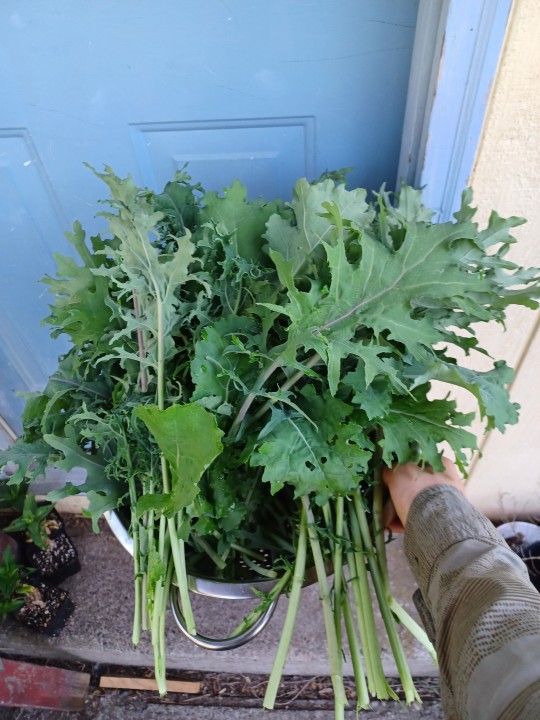
I'll keep making selections over the next year or so, removing from the gene pool any that are too bug eaten, or don't make it through winter, or bolt way early next spring.
Now, I'm not an expert here, and I'm doing this very casually, but I've been very happy with the results so far. If you want to learn more, I really liked Carol Deppe's book about breeding vegetables.
384 notes
·
View notes